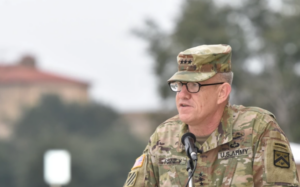The Army has nominated Lt. Gen. James Rainey, the service’s deputy chief of staff for operations, and training, to be the next leader of the modernization-focused Army Futures Command (AFC).
Army Under Secretary Gabe Camarillo confirmed the news on Wednesday, which arrives nine months after Futures Commands’ first leader retired from the service.

“[Army] Secretary [Christine] Wormuth and the entire Army team has been fully behind getting that new commander of AFC as soon as we possibly can. And I think we said that pretty consistently for the last couple of months. We’re very thrilled with the announcement that Lt. Gen. Jim Rainey, who is our current G-3/5/7 in the Army headquarters, is nominated and, if confirmed, will serve as the next or second AFC commander in the command’s history,” Camarillo said during a discussion at the Defense News Conference.
Rainey, if confirmed, would succeed Ret. Gen. Mike Murray who was Futures Command’s first leader from its founding in August 2018 through his retirement from the Army in December 2021.
Lt. Gen. James Richardson, AFC’s deputy commanding general, has served as Futures Command’s acting leader since Murray’s retirement.
Camarillo cited Rainey’s “wealth of experience and knowledge” as a critical component to his likely future role helping to shape the Army’s long-term modernization initiatives.
“Having served as the G-3/5/7, he’s got a lot of experience in the Pentagon on the Army’s operational needs and capabilities. He understands the budget having worked those issues for the last several years in the Pentagon as well. And I would also note, he’s got a lot of operational experience as well to draw back on,” Camarillo cited, also citing Rainey’s experience as former commander of the Combined Arms Center at Fort Leavenworth in Kansas. “That is a tremendous asset and background and experience that I think he’ll be able to take into the job if he’s confirmed by the Senate Armed Services [Committee].”
If confirmed, Rainey would take helm of the Austin, Texas-based Futures Command as the Army begins to assess how the organization will help shape the service beyond its current modernization portfolio.
Wormuth in May signed a new directive that more narrowly defined Futures Command’s roles, which she has said was aimed at addressing any ambiguities in the responsibilities between AFC and the Army’s acquisition office (Defense Daily, May 5).
The memo eliminated previous language from earlier guidance that established Futures Command as “leading the modernization enterprise” and reiterated that the assistant secretary of the Army for acquisition, logistics and technology (ASA(ALT)) office owns both acquisition and oversight of research and development (R&D) efforts.
During a House Appropriations Defense Subcommittee hearing in May, Wormuth reiterated there are no plans to downgrade Futures Command in the wake of a recent memo and that it will remain a four-star command (Defense Daily, May 17).
Richardson previously told the House Armed Services Committee, following the memo’s release, that he viewed Futures Command as “the engine of Army modernization.”
“Day to day work at AFC is not changing. We develop. We integrate concepts, technology, requirements and force design. And AFC is really the engine behind that modernization. We execute the integration and the synchronization of modernization across the enterprise,” Richardson said at the time.